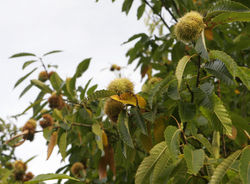Chestnut: Difference between revisions
Pollinator (talk | contribs) Fine to add Celsius; unfriendly to remove Fahrenheit |
m remove inapprop Category:Wood |
||
| Line 59: | Line 59: | ||
[[Category:Fagaceae]] |
[[Category:Fagaceae]] |
||
[[category: wood]] |
|||
[[bg:Кестен]] |
[[bg:Кестен]] |
||
Revision as of 17:55, 22 May 2006
- For other uses, see Chestnut (disambiguation). "Chinkapin" redirects here; for the oak tree, see Chinkapin oak.
| Chestnut | |
|---|---|

| |
| Sweet Chestnut | |
| Scientific classification | |
| Kingdom: | |
| Division: | |
| Class: | |
| Order: | |
| Family: | |
| Genus: | Castanea
|
| Species | |
|
C. alnifolia - Bush Chinkapin* | |
Chestnuts (Castanea), including the chinkapins, are a genus of eight or nine species of trees and shrubs in the beech family Fagaceae, native to warm temperate regions of the Northern Hemisphere. The name also refers to the edible nuts produced by these trees. Most are large trees to 20-40 m tall, but some species (the chinkapins) are smaller, often shrubby. All are deciduous.
The leaves are simple, ovate or lanceolate, 10-30 cm long and 4-10 cm broad, with sharply pointed, widely-spaced teeth, with shallow rounded sinuses between. The flowers are catkins, produced in mid summer. The fruit is a spiny cupule 5-11 cm diameter, containing 2-7 nuts.
Castanea species are used as food plants by the larvae of some Lepidoptera species - see list of Lepidoptera which feed on Castanea.
The American Chestnut, formerly one of the dominant trees of the eastern United States, has been almost wiped out by a fungal disease, chestnut blight, Cryphonectria parasitica. The American chinkapins are also very susceptible to chestnut blight. The European and west Asian Sweet Chestnut is susceptible, but less so than the American, and the east Asian species are resistant. These resistant species, particularly Japanese Chestnut and Chinese Chestnut but also Seguin's Chestnut and Henry's Chestnut, have been used in breeding programs in the US to create hybrids with the American chestnut that are also disease resistant.
Neither the horse chestnut (family Sapindaceae) nor the water chestnut (family Cyperaceae) is closely related to the chestnut, though both are so named for producing similar nuts.
Uses

The nuts are most commonly eaten candied or roasted; the former are often sold under the French name marrons glacés. One easy method for roasting is to cut a slit in the top of each nut and heat in a shallow container, tossing occasionally, at 200C/400F for 30 minutes.
To preserve chestnuts to eat through the winter, they must be made perfectly dry after they come out of their green husk; then put into a box or a barrel mixed with, and covered over by, fine and dry sand, three parts of sand to one part of chestnuts. Any maggots in any of the chestnuts will emerge and work up through the sand to get to the air without damaging other chestnuts. Chestnuts to be grown in the spring need to be kept in moist sand and chilled over the winter.
The wood is similar to oak wood in being decorative and very durable. Due to disease, American Chestnut wood has almost disappeared from the market. It is difficult to obtain large size timber from the Sweet Chestnut, due to the high degree of splitting and warping when it dries. The wood of the Sweet Chestnut is most used in small items where durability is important, such as fencing and wooden outdoor cladding ('shingles') for buildings. In Italy, it is also used to make barrels used for aging balsamic vinegar.
The bark was also a useful source of natural tannins, used for tanning leather before the introduction of synthetic tannins.
-
Ripe Sweet Chestnuts
-
Chestnuts inside their spiky capsule
-
Chestnuts can be found on the ground around trees
-
A Sweet Chestnut tree
-
A Sweet Chestnut tree
-
Sweet Chestnut male catkins (pale buff) and female catkins (green, spiny, partly hidden by leaves)
-
Young chestnuts







